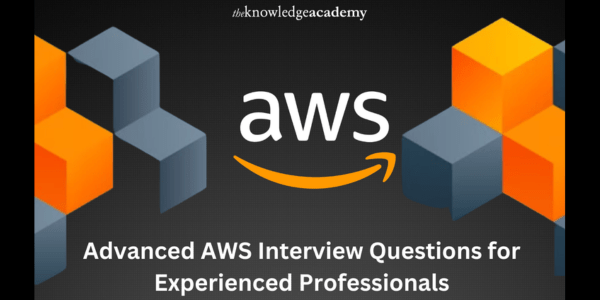
Advanced AWS Interview Questions for Experienced Professionals
Amazon Web Services (AWS) is a renowned in the cloud computing space. It provides an extensive range of tools and services that enable enterprises to develop and implement scalable, dependable and reasonably priced solutions. The depth and complexity of AWS Interview Questions for seasoned experts are rising along with the demand for AWS competence. This blog will explore advanced interview questions for Amazon aimed at testing and assessing experienced practitioners knowledge and ensuring they have the abilities needed to take on complex cloud-based problems.
Table of Contents
- Understanding the Landscape
- Advanced AWS Interview Questions
- Conclusion
Understanding the Landscape
Before getting into specifics, it is essential to comprehend AWS. Experts in the field should be well versed in cloud architecture, security, cost optimisation, performance tweaking, best practices and AWS services. They should also know various deployment and automation tools and have experience creating and overseeing intricate, multi-tiered applications.
Advanced AWS Interview Questions
Architecture and Design
How would you create a scalable and highly available web application architecture on Amazon Web Services?
The following are essential elements of building a highly available and scalable architecture on AWS:
- Elastic Load Balancer [ELB]: This type of load balancer provides high availability by distributing incoming traffic among several instances located in various Availability Zones [AZs].
- Auto Scaling Group [ASG]: This feature offers scalability by automatically adjusting the number of EC2 instances according to traffic requirements.
- Amazon RDS with Multi AZ Deployment: Database availability is ensured using Amazon RDS with Multi AZ Deployment which automatically replicates data to a standby instance in a different AZ.
- Amazon S3: Provides scalability and durability for storing static content such as backups, videos and photos.
- Amazon CloudFront: Enhances performance by cutting latency and distributing material worldwide.
- AWS Route 53: Offers failover, health checks and managing DNS.
- Amazon VPC: Increases security by isolating the application inside a private network.
- Security Groups and Network ACLs: Control incoming and outgoing traffic to instances and subnets with Security Groups and Network ACLs.
Security and Compliance
How do you ensure data security in AWS?
Multiple levels of protection are necessary to ensure data security on AWS.
- Identity and Access Management (IAM): IAM roles, rules and multi factor authentication [MFA] are used to manage access control.
- Encryption: To encrypt data while it is at rest use server side encryption on Amazon S3 and AWS Key Management Service (KMS). To encrypt data while it is in transit use SSL/TLS.
- VPC Security: To manage traffic flow and isolate resources use network ACLs, security groups and VPC endpoints.
- AWS Config with CloudTrail: Track and document resource configurations and account activity for auditing and compliance purposes.
- AWS Shield and WAF: Secure online applications and defend against DDoS assaults with Amazon Shield and WAF.
- GuardDuty: Always keep an eye out for any unauthorised or malicious behaviour.
Cost Optimization
What tactics would you use to maximise the cost of AWS?
Several AWS cost-optimization techniques are:
- Right Sizing Instances: Examine and modify instance sizes regularly by utilisation data.
- Reserved Instances and Savings Plans: To save money by Savings Plans or Reserved Instances for predictable workloads.
- Spot Instances: Use Spot Instances for non critical or flexible workloads to benefit from unused EC2 capacity at a reduced cost.
- Auto Scaling: To avoid over provisioning, use Auto Scaling to adjust the number of instances to demand.
- Cost Explorer and Budgets: Establish budgets and alerts to monitor and manage costs and use AWS Cost Explorer to examine spending trends.
- S3 Storage Classes: Use various S3 storage classes according to data access patterns (eg S3 Standard, S3 Infrequent Access, S3 Glacier).
- Lambda Functions: For event driven applications switch to AWS Lambda instead of traditional computing instances to cut expenses by paying for usage.
Performance and Optimization
In an AWS environment, how can performance be optimised?
To optimise performance on AWS, one must:
- Auto Scaling: Resources are automatically adjusted based on demand to maintain performance levels.
- Load balancing: To avoid any one instance from becoming a bottleneck, use ELB to split traffic evenly among many cases.
- Caching: Use caching techniques like Amazon CloudFront, AWS Global Accelerator, and Amazon ElastiCache to lower latency and speed up response times.
- Database optimisation: To increase database speed, partitioning, indexing, and reading replicas from Amazon RDS is used. If you require a high performance database, use Amazon Aurora.
- Instance Types: Based on the workload’s demands, choose the proper instance types (e.g., compute optimized, memory optimized, storage optimized).
- Monitoring and Tuning: AWS X-Ray and Amazon CloudWatch continuously monitor performance indicators. Based on these findings, adjust the infrastructure and apps.
Troubleshooting and Monitoring
What is the process for debugging performance problems in an AWS environment?
The process of debugging performance problems in AWS entails the following:
- Amazon CloudWatch: Track and evaluate performance indicators and create alerts to spot problems.
- AWS X-Ray: Track requests via your programme to find snags in processing and other performance problems.
- Elastic Load Balancer Logs: To comprehend traffic patterns and spot problems, examine ELB access logs.
- VPC Flow Logs: Monitor and examine network traffic going to and from your VPC to spot possible network problems.
- Application Logs: To collect and examine application logs, use AWS CloudTrail, CloudWatch Logs and AWS Lambda logging.
- Resource Utilisation Metrics: To find performance bottlenecks, examine the CPU, memory, disc I/O and network utilization metrics for EC2 instances and other resources.
Conclusion
A solid grasp of AWS services, best practices, and the capacity to create and oversee intricate cloud infrastructures are necessary to successfully navigate difficult AWS interview questions. Experts in architecture and design, security, cost optimisation, performance tuning, deployment automation, and troubleshooting should be ready to showcase their knowledge. Gaining proficiency in these areas, as emphasized by The Knowledge Academy, will enable you to confidently address the trickiest issues during an AWS interview and demonstrate how to use AWS to create complex, high-performing, secure cloud solutions.




